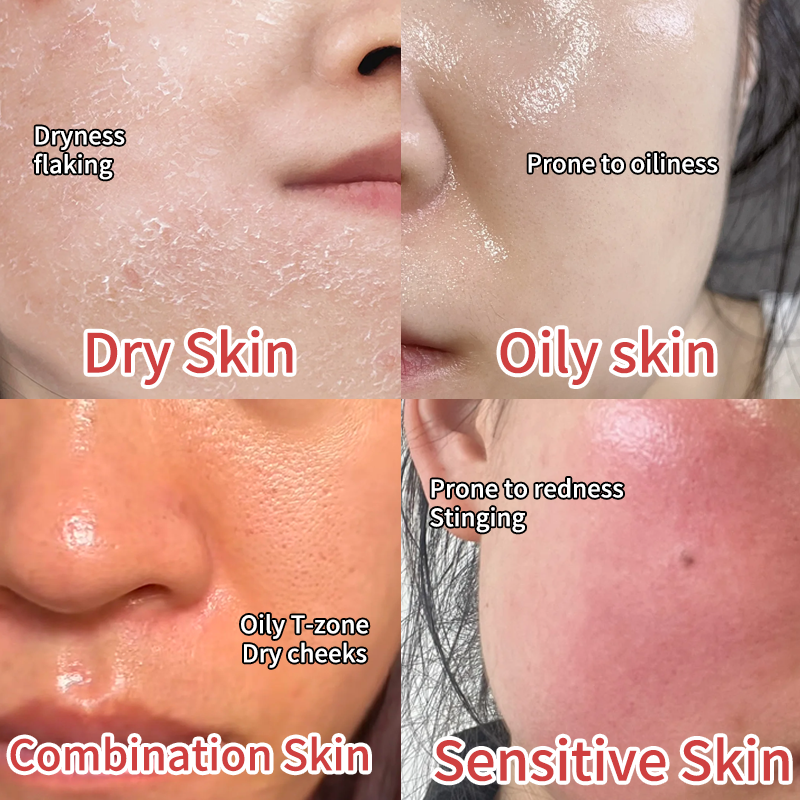
How to Choose the Right Foundation for Different Skin Types? The Ultimate Guide for Dry, Oily, and Combination Skin
Share
Foundation Guide: Dry, Oily & Combination Skin Explained
Ever stood in front of endless foundations and felt totally confused? Bought one that cakes, flakes, or melts off halfway through the day? Here’s the trick: know your skin, pick the right formula + method. This guide has you covered—no more foundation fails!
Step 1: Identify Your Skin Type
Before choosing a foundation, take 30 seconds to determine your skin type:
-
Dry Skin: Feels tight and flaky, prone to dry patches and fine lines. Makeup often looks cakey.
-
Oily Skin: Shiny all over, especially in the T-zone (forehead, nose, chin). Large pores, makeup tends to slide off or look dull.
-
Combination Skin: Oily in the T-zone, dry or normal on the cheeks. This is the most common type and needs targeted care.
-
Sensitive Skin: Easily irritated, prone to redness and stinging. Requires gentle, additive-free formulas.

Step 2: Choose the Right Foundation for Your Skin
1. For Dry Skin: Hydrating, Moisturizing, Dewy Finish
-
Texture Keywords: hydrating, lightweight, lotion/cream-based. Look for foundations with moisturizing ingredients like hyaluronic acid or glycerin.
-
Finish Keywords: radiant, luminous, “cream skin.” These formulas combat dryness and make your complexion look plump and glowing.
-
✅ Recommended Product: [Flawless, Transfer-Resistant & Shine-Free]. Packed with skincare-level hydration, this foundation keeps skin nourished and prevents cakiness all day.
2. For Oily Skin: Oil-Control, Long-Wear, Matte Finish
-
Texture Keywords: oil-free, water-based, long-lasting.
-
Finish Keywords: matte, shine-free. Absorbs excess oil for a fresh, clean look.
-
✅ Recommended Product: [Matte Foundation for Oily Skin]. This ultra-long-wear formula keeps oil at bay, ensuring your base stays intact—even in hot summer weather.
3. For Combination Skin: Balance and Zone-Specific Care
-
Core Strategy: Balance the needs of your oily T-zone and drier cheeks. Opt for a natural-finish foundation with medium coverage and a semi-matte look.
-
Pro Tip: Use a mattifying primer on the T-zone, a hydrating primer on the cheeks, then apply one foundation all over.
-
✅ Recommended Product: [Combination Skin: The Balanced Choice]. This smart formula adapts to different zones—controlling shine in oily areas while keeping dry patches hydrated.
Step 3: Application Techniques by Skin Type
Universal Prep: Always moisturize and apply primer before foundation for a smoother, longer-lasting base.
-
Tools:
-
Beauty Sponge: Works for all skin types. Dampen, squeeze out excess water, and bounce foundation onto skin for a seamless finish.
-
Foundation Brush: Best for higher coverage. Use circular motions or sweeping strokes. (Dry skin should be careful of brush streaks.)
-
-
Spot Application: Apply foundation in small dots across the face, blending as you go. Avoid dotting the whole face at once—it can dry before you spread it.
-
Techniques by Skin Type:
-
Dry Skin: Pat & Press. Use a damp sponge to bounce foundation quickly into skin. Press gently around dry-prone areas like the nose and under-eyes.
-
Oily Skin: Brush & Bounce. Spread evenly with a brush, then tap lightly with a dry sponge to absorb extra oil for longer wear.
-
Combination Skin: Zone-Specific. Apply lightly to the T-zone, using sponge residue only. Use normal amounts on the cheeks, then set with a hydrating mist instead of powder.

-
Wrap-Up & Call to Action
Remember this formula:
Flawless Base = Knowing Your Skin Type + Choosing the Right Product + Using Proper Technique
Now that you’ve got the theory, it’s time to put it into practice!
➡️ [Viral Matte Foundation] Click here to explore our curated foundation lineup and find your perfect match.
Community Question: What’s the best foundation you’ve ever tried? Drop your skin type and holy-grail product in the comments to help others find their match! 💬